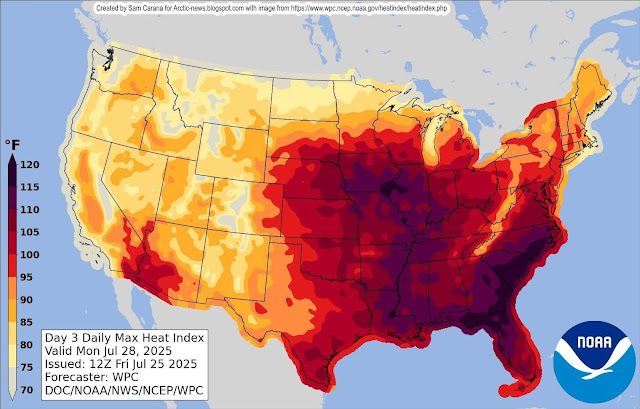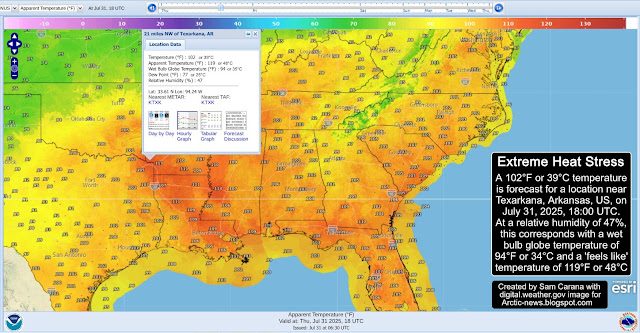Wet Bulb Globe Temperature (WBGT) takes into account the effect of temperature, RH (relative humidity), wind speed, and solar radiation. WBGT is used by weather.gov to warn about extreme heat stress when in direct sunlight, as is forecast to occur in grey areas on July 26, 2024 at 21 UTC.
 |
| [ click on images to enlarge ] |
The inset shows that a temperature of 113°F or 45°C and a Wet Bulb Globe Temperature of 95°F or 35°C is forecast for a location 8 miles south of Parker, Arizona, on July 26, 2024 at 21 UTC.
The above map illustrates that extreme heat stress can occur at higher latitudes, e.g. the grey areas in the north of the United States that extend into Canada. The danger occurs where high temperatures coincide with high relative humidity.
The image below further illustrates the danger. It shows that a 'feel like' temperature of 54°C (129.1°F) and a wet bulb temperature of 31°C (87.7°F) hit an area west of Wuhan, China, on July 23, 2024 at 10:00 UTC (green circle).
The temperature at that location in China wasn't the highest on the map, it was 36.4°C (97.4°F), which is high, but what further contributed to make conditions hard to bear was that relative humidity was 68%.
The image on the right, adapted from Climate Reanalyzer, shows a 3-day forecast of temperatures in the region, run on July 23, 2024.
Heat stress is the leading cause of weather-related deaths in the United States, as illustrated by the image below (credit:
NOAA).
As the above image notes, the values for heat fatalities may be conservative.
Research finds that where heat is being listed as an official cause of death, this likely underestimates the full toll of these events. Extreme heat can trigger heart attacks and strokes. In addition, some heart disease risk factors, such as diabetes—as well as heart medications, such as diuretics and beta blockers—can affect a person’s ability to regulate their body temperature and make it difficult to handle extreme heat. The study finds that extreme heat accounted for about 600-700 additional deaths from cardiovascular disease annually. A
study estimates that extreme heat accounted for 12,000 premature deaths in the contiguous U.S. from 2000 to 2010, and an
analysis calculates that the summer 2022 heatwave killed 61,000 people in Europe alone.
As temperatures and humidity levels keep rising, a tipping point can be reached where the wind factor no longer matters, in the sense that wind can no longer provide cooling. The human body can cool itself by sweating, which has a physiological limit that was long described as a 35°C wet-bulb temperature. Once the wet-bulb temperature reaches 35°C, one can no longer lose heat by perspiration, even in strong wind, but instead one will start gaining heat from the air beyond a wet-bulb temperature of 35°C.
Accordingly, a 35°C wet-bulb temperature (equal to 95°F at 100% humidity or 115°F at 50% humidity) was long seen as the theoretical limit, the maximum a human could endure.
A
2020 study (by Raymond et al.) warns that this limit could be regularly exceeded with a temperature rise of less than 2.5°C (compared to pre-industrial). A
2018 study (by Strona & Bradshaw) indicates that most life on Earth will disappear with a 5°C rise. Humans, who depend for their survival on many other species, will likely go extinct with a 3°C rise, as illustrated by the image below, from an
earlier post.
A
2022 study (by Vecellio et al.) finds that the actual limit is lower — about 31°C wet-bulb or 87°F at 100% humidity — even for young, healthy subjects. The temperature for older populations, who are more vulnerable to heat, is likely even lower. In practice the limit will typically be lower and depending on circumstances could be as low as a wet-bulb temperature of 25°C.
The image below,
earlier discussed here, expands risk assessment beyond its typical definition as the product of the severity of impact and probability of occurrence, by adding a third dimension: timescale, in particular imminence.
Imminence alone could make that the danger constituted by rising temperatures needs to be acted upon immediately, comprehensively and effectively. While questions may remain regarding probability, severity and timescale of the dangers associated with climate change, the precautionary principle should prevail and this should prompt for action, i.e. comprehensive and effective action to reduce damage and improve the situation is imperative and must be taken as soon as possible.
Rapidly rising temperatures constitute tipping points in several ways
Firstly, there is a biological threshold beyond which rising temperatures become lethal for humans, as discussed above.
Secondly, as Gerardo Ceballos describes in the video below and in a
2017 analysis, there is a biological tipping point that threatens annihilation of species via the ongoing sixth mass extinction. Researchers such as
Gerardo Ceballos (2020),
Kevin Burke (2018) and
Ignation Quintero (2013) have for years warned that mammals and vertebrates cannot keep up with the rapid rise in temperature. Humans are classified as vertebrate mammals, indicating that we will not avoid the fate of extinction,
Guy McPherson (2020) adds.
Thirdly, there are further tipping points, e.g. social-political ones. On the one hand, it would be good if people became more aware, as this could prompt more people into supporting the necessary action. On the other hand, as temperatures keep rising, there is also a danger that panic will break out, dictators will grab power and civilization as we know it will collapse abruptly, as warned about earlier, e.g.
in 2007.
Climate Emergency Declaration
The situation is dire and the precautionary principle calls for rapid, comprehensive and effective action to reduce the damage and to improve the situation, as described in
this 2022 post, where needed in combination with a Climate Emergency Declaration, as discussed at
this group.
Links
• Wet Bulb Globe Temperature
https://digital.mdl.nws.noaa.gov
• National Weather Service - Wet Bulb Globe Temperature: How and when to use it
https://www.weather.gov/news/211009-WBGT
• The emergence of heat and humidity too severe for human tolerance - by Colin Raymons et al. (2020)
https://www.science.org/doi/10.1126/sciadv.aaw1838
• Brief periods of dangerous humid heat arrive decades early
https://www.climate.gov/news-features/featured-images/brief-periods-dangerous-humid-heat-arrive-decades-early
• Evaluating the 35°C wet-bulb temperature adaptability threshold for young, healthy subjects (PSU HEAT Project) - by Daniel Vecellio et al. (2022)
https://journals.physiology.org/doi/full/10.1152/japplphysiol.00738.2021Discussed at facebook at:
https://www.facebook.com/groups/arcticnews/posts/10159973158374679
• NOAA - Weather Fatalities 2022
https://www.weather.gov/hazstat• The Effects of Heat Exposure on Human Mortality Throughout the United States - by Drew Shindell (2021)
https://agupubs.onlinelibrary.wiley.com/doi/full/10.1029/2019GH000234
• Heat-related mortality in Europe during the summer of 2022 - by Joan Ballester et al.
https://www.nature.com/articles/s41591-023-02419-zDiscussed at facebook at:
https://www.facebook.com/groups/arcticnews/posts/10160875637104679
• As Temperatures Spike, So Do Deaths from Heart Disease (2022 News release)
https://www.acc.org/About-ACC/Press-Releases/2022/03/22/20/06/As-Temperatures-Spike-So-Do-Deaths-from-Heart-Disease
• Association of Extreme Heat and Cardiovascular Mortality in the United States: A County-Level Longitudinal Analysis From 2008 to 2017 - by Sameed Khatana et al. (2022)
https://www.ahajournals.org/doi/10.1161/CIRCULATIONAHA.122.060746
• Co-extinctions annihilate planetary life during extreme environmental change, by Giovanni Strona and Corey Bradshaw (2018)
https://www.nature.com/articles/s41598-018-35068-1Discussed at facebook at:
https://www.facebook.com/groups/arcticnews/posts/10156903792219679
• When will we die?
https://arctic-news.blogspot.com/2019/06/when-will-we-die.html• Climate Reanalyzer - Hourly Forecast Maps
https://climatereanalyzer.org/wx/fcst/?mdl_id=nam&dm_id=conus-lc&wm_id=t2
• PBS video - Too HOT and HUMID to Live: Extreme Wet Bulb Events are on the Rise
https://www.pbs.org/video/too-hot-and-humid-to-live-extreme-wet-bulb-events-are-on-th-fazocs
• Nullschool
https://earth.nullschool.net• How agriculture hastens species extinction | 60 Minutes (CBS News) | Gerardo Ceballos
https://www.youtube.com/watch?app=desktop&v=f21WWocqR-c
• Biological annihilation via the ongoing sixth mass extinction signaled by vertebrate population losses and declines - by Gerardo Ceballos, Paul R. Ehrlich and Rodolfo Dirzo (2017)
https://www.pnas.org/content/114/30/E6089
• Vertebrates on the brink as indicators of biological annihilation and the sixth mass extinction - by Gerardo Ceballos, Paul Ehrlich, and Peter Raven (2020)
https://www.pnas.org/content/early/2020/05/27/1922686117Discussed at facebook at:
https://www.facebook.com/groups/arcticnews/posts/10158460232764679
• Rates of projected climate change dramatically exceed past rates of climatic niche evolution among vertebrate species - by Ignatio Quintero et al. (2013)
https://onlinelibrary.wiley.com/doi/abs/10.1111/ele.12144
• Pliocene and Eocene provide best analogs for near-future climates - by Kevin Burke et al. (2018)
https://www.pnas.org/doi/10.1073/pnas.1809600115Discussed at facebook at:
https://www.facebook.com/groups/arcticnews/posts/10156972951354679
• Earth is in the Midst of Abrupt, Irreversible Climate Change - by Guy McPherson (2020)
https://www.onlinescientificresearch.com/articles/earth-is-in-the-midst-of-abrupt-irreversible-climate-change.pdfDiscussed at facebook at:
https://www.facebook.com/groups/arcticnews/posts/10160004947844679
• Ten Dangers of Global Warming
https://arctic-news.blogspot.com/p/ten-dangers-of-global-warming.html• Wet Bulb Globe Temperature Tipping Point
https://arctic-news.blogspot.com/2023/07/wet-bulb-globe-temperature-tipping-point.html
• Extreme heat stress
https://arctic-news.blogspot.com/2023/06/extreme-heat-stress.html• Transforming Society
https://arctic-news.blogspot.com/2022/10/transforming-society.html
• Climate Plan
https://arctic-news.blogspot.com/p/climateplan.html
• Climate Emergency Declaration
https://arctic-news.blogspot.com/p/climate-emergency-declaration.html



























